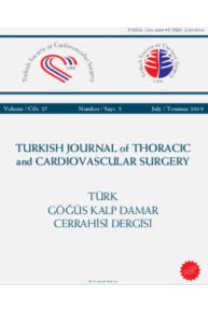Endovascular repair of dissecting abdominal aortic aneurism under spinal anesthesia in a patient with pulmonary embolus
Pulmoner embolisi olan bir hastada dissekan abdominal aort anevrizmasının spinal anestezi altında endovasküler onarımı
___
- 1. Parodi JC, Palmaz JC, Barone HD. Transfemoral intraluminal graft implantation for abdominal aortic aneurysms. Ann Vasc Surg 1991;5:491-9.
- 2. Dotter CT. Transluminally-placed coilspring endarterial tube grafts. Long-term patency in canine popliteal artery. Invest Radiol 1969;4:329-32.
- 3. Ehrlich M, Grabenwoeger M, Cartes-Zumelzu F, Grimm M, Petzl D, Lammer J, et al. Endovascular stent graft repair for aneurysms on the descending thoracic aorta. Ann Thorac Surg 1998;66:19-24.
- 4. Verhoeven EL, Cinà CS, Tielliu IF, Zeebregts CJ, Prins TR, Eindhoven GB, et al. Local anesthesia for endovascular abdominal aortic aneurysm repair. J Vasc Surg 2005;42:402-9.
- 5. Moskowitz DM, Kahn RA, Marin ML, Hollier LH. Intraoperative rupture of an abdominal aortic aneurysm during an endovascular stent-graft procedure. Can J Anaesth 1999;46:887-90.
- 6. Huang JJ. Spinal anesthesia for endoluminal abdominal aortic aneurysm repair. J Clin Anesth 2002;14:176-8.
- 7. Kalko Y, Ugurlucan M, Basaran M, Aydin U, Kafa U, Kosker T, et al. Epidural anaesthesia and mini-laparotomy for the treatment of abdominal aortic aneurysms in patients with severe chronic obstructive pulmonary disease. Acta Chir Belg 2007;107:307-12.
- 8. Bush RL, Lin PH, Reddy PP, Chen C, Weiss VJ, Guinn G, et al. Epidural analgesia in patients with chronic obstructive pulmonary disease undergoing transperitoneal abdominal aortic aneurysmorraphy-a multi-institutional analysis. Cardiovasc Surg 2003;11:179-84.
- 9. Barrington MJ, Kluger R, Watson R, Scott DA, Harris KJ. Epidural anesthesia for coronary artery bypass surgery compared with general anesthesia alone does not reduce biochemical markers of myocardial damage. Anesth Analg 2005;100:921-8.
- 10. Baker AB, Lloyd G, Fraser TA, Bookallil MJ, Yezerski SD. Retrospective review of 100 cases of endoluminal aortic stent-graft surgery from an anaesthetic perspective. Anaesth Intensive Care 1997;25:378-84.
- 11. Aadahl P, Lundbom J, Hatlinghus S, Myhre HO. Regional anesthesia for endovascular treatment of abdominal aortic aneurysms. J Endovasc Surg 1997;4:56-61.
- 12. Eberle B, Weiler N, Düber C, Schmiedt W, Wisser G, Tzanova I, et al. Anesthesia in endovascular treatment of aortic aneurysm. Results and perioperative risks. Anaesthesist 1996;45:931-40. [Abstract]
- 13. Henretta JP, Hodgson KJ, Mattos MA, Karch LA, Hurlbert SN, Sternbach Y, et al. Feasibility of endovascular repair of abdominal aortic aneurysms with local anesthesia with intravenous sedation. J Vasc Surg 1999;29:793-8.
- 14. Raggi R, Dardik H, Mauro AL. Continuous epidural anesthesia and postoperative epidural narcotics in vascular surgery. Am J Surg 1987;154:192-7.
- 15. Cao P, Zannetti S, Parlani G, Verzini F, Caporali S, Spaccatini A, et al. Epidural anesthesia reduces length of hospitalization after endoluminal abdominal aortic aneurysm repair. J Vasc Surg 1999;30:651-7.
- 16. Rao TL, El-Etr AA. Anticoagulation following placement of epidural and subarachnoid catheters: an evaluation of neurologic sequelae. Anesthesiology 1981;55:618-20.
- 17. Gilman AG, Rall TW, Nies AS, Taylor P, editors. The Pharmacological Basis of Therapeutics. 8th ed. New York: Pergamon Press;1990.
- 18. Wax DB, Garcia C, Campbell N, Marin ML, Neustein S. Anesthetic experience with endovascular aortic aneurysm repair. Vasc Endovascular Surg 2010;44:279-81.
- 19. Ruppert V, Leurs LJ, Steckmeier B, Buth J, Umscheid T. Influence of anesthesia type on outcome after endovascular aortic aneurysm repair: an analysis based on EUROSTAR data. J Vasc Surg 2006;44:16-21.
- 20. Horlocker TT, Heit JA. Low molecular weight heparin: biochemistry, pharmacology, perioperative prophylaxis regimens, and guidelines for regional anesthetic management. Anesth Analg 1997;85:874-85.
- 21. Rigler ML, Drasner K, Krejcie TC, Yelich SJ, Scholnick FT, DeFontes J, et al. Cauda equina syndrome after continuous spinal anesthesia. Anesth Analg 1991;72:275-81.
- ISSN: 1301-5680
- Yayın Aralığı: 4
- Başlangıç: 1991
- Yayıncı: Bayçınar Tıbbi Yayıncılık
Karotis cerrahisinde itraluminal şantın rutin olarak uygulanması gerekli midir?
Türkiye’deki kalp damar cerrahisi kliniklerinin dağılımı ve hizmetlerinin niteliği
Ümit KERVAN, Mustafa PAÇ, Orhan KOÇ, Gültekin BAYRAKTAR, İbrahim YEKELER, Mehmet Ali ÖZATİK, Erol ŞENER, Kerim ÇAĞLI
A new bridge bypass technique for multisegmental left anterior descending coronary artery disease
Ömer TETİK, Yüksel BEŞİR, Arif GÜCÜ, Önder T. BOZKURT, Orhan RODOPLU, Tamer TÜRK
Ameliyat sırasında perikardda oluşan değişiklikler: Bir elektronmikroskopi çalışması
Erkan İRİZ, Candan ÖZOĞUL, Adem GRBOLAR, Hüseyin BAYRAM, Yeşim BARDAKÇI, Ali YENER, Nuran YENER
Plevranın soliter fibröz tümörleri
Yener YÖRÜK, Yekta Altemur KARAMUSTAFAOĞLU, Sevinç YAĞCI
Simultaneous gastrectomy and off-pump coronary artery bypass grafting: a case report
Sinan ARSAN, Ali CİVELEK, Cumhur YEĞEN, Cemil Selim İSBİR, Koray AK
Kalp nakli yapılan hastalarda uzun dönem sağkalımı etkileyen faktörlerin incelenmesi
Kerem VURAL, Ümit KERVAN, Mustafa PAÇ, Şeref KÜÇÜKER, Mahmut Mustafa ULAŞ, Sinan Sabit KOCABEYOĞLU, Mehmet Ali ÖZATİK, İrfan TAŞOĞLU
Yüksel BEŞİR, Levent YILIK, Orhan GÖKALP, Mert KESTELLİ, Haydar YAŞA, Ali GÜRBÜZ, Ufuk YETKİN, İsmail YÜREKLİ
Plevranın soliter fibröz tümörü:
İbrahim ÖZTEK, Recep DEMİRHAN, Burak ONAN
Ersin EREK, Yasemin TÜRKEKUL, Ayşe ULUKOL, Cafer Tayyar SARIOĞLU, Arda SAYGILI, Yusuf Kenan YALÇINBAŞ
